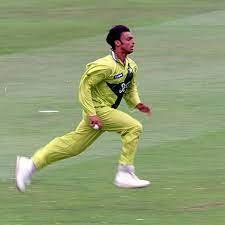
Shoaib Akhtar’s 161.3 km/h: The Fas
In the history of cricket, few records stand as tall as Shoaib Akhtar’s legendary 161.3 km/h delivery. Bowled in the 2003 Cricket World Cup, this blistering pace made Akhtar not only the fastest bowler in the history of the sport but also left a lasting mark on the game. In this article, we will explore the significance of Akhtar’s record-breaking ball, the impact of his speed on cricket, and how he redefined fast bowling.
The Man Behind the Record: Shoaib Akhtar
Shoaib Akhtar, known as the “Rawalpindi Express,” was a bowler whose sheer pace and intimidating presence on the field captivated cricket fans worldwide. Born on August 13, 1975, in Rawalpindi, Pakistan, Akhtar’s natural talent for fast bowling quickly became evident. His career, which spanned over a decade, was marked by sheer aggression, remarkable athleticism, and, most importantly, shoaib akhtar fastest ball career was filled with several memorable moments, but his fastest delivery remains his defining achievement. On February 22, 2003, during the 2003 ICC Cricket World Cup match between Pakistan and England, Shoaib Akhtar bowled the fastest delivery ever recorded in cricket history—a jaw-dropping 161.3 km/h (100.23 mph). This speed set a benchmark in the cricketing world and left a legacy that still stands to this day.
The Record-Breaking Moment
It was in Cape Town, South Africa, where Shoaib Akhtar unleashed the record-breaking delivery. During the group-stage match between Pakistan and England, Akhtar delivered a scorching ball to England’s Nick Knight. The delivery was not just a display of sheer pace but also a testament to Akhtar’s ability to bowl with accuracy at unimaginable speeds. The speed was measured at 161.3 km/h, and it surpassed the previous record of 161.1 km/h, held by the legendary Australian bowler, Brett Lee. Akhtar’s delivery was not just about speed—it was a combination of aggression, technique, and raw power, which made it such a remarkable feat in cricket history.
The Impact on Cricket
Shoaib Akhtar’s 161.3 km/h delivery wasn’t just a personal milestone; it was a game-changer for the world of cricket. His blistering pace set new standards for fast bowlers, pushing the boundaries of what was considered possible. Akhtar’s record prompted other fast bowlers to elevate their training and approach, as the focus shifted toward speed and intensity. However, while Akhtar’s record remains intact, the toll that fast bowling takes on the body became increasingly evident. Akhtar himself struggled with injuries throughout his career, and his body was often subjected to immense stress due to the force required to bowl at such speeds. Despite this, his dedication to the game and his ability to bowl consistently at over 150 km/h made him an iconic figure in the world of fast bowling.
Shoaib Akhtar’s Influence on Future Fast Bowlers
Akhtar’s speed and aggression inspired a generation of bowlers who sought to emulate his fiery pace. Fast bowlers like Dale Steyn, James Anderson, and even the likes of Mohammad Amir have acknowledged the influence shoaib akhtar bowling speed had on their careers. The focus on bowling speed, coupled with a never-say-die attitude, is something that Akhtar instilled in many of his contemporaries. While Akhtar’s record is yet to be broken, his legacy goes beyond just the numbers. He is remembered as one of the most menacing fast bowlers in cricket history—a bowler who, with his sheer pace and intimidating presence, was capable of rattling even the most experienced batsmen.

The Evolution of Fast Bowling
The emergence of Shoaib Akhtar as the fastest bowler in the world signified a shift in how fast bowling was perceived. Before Akhtar, bowlers like Richard Hadlee, Kapil Dev, and Curtly Ambrose had redefined fast bowling in their own right. But Akhtar took things to a whole new level, with his relentless pursuit of speed that left batsmen quaking in their boots. Since Akhtar’s peak, the sport has evolved, with technology like speed guns becoming more accurate in measuring ball speed. Bowlers today have continued to push the limits of pace, with the likes of Brett Lee, Shaun Tait, and more recently, Mohammad Sami and Lockie Ferguson, challenging the 160 km/h mark. Despite these advances, Shoaib Akhtar’s 161.3 km/h delivery remains a monumental record in the annals of cricket history.
Akhtar’s Legacy
While Akhtar’s career was marred by injuries and controversies, there is no denying the impact he had on the game. His blazing pace and powerful presence on the field made him a fan favorite and one of the most entertaining cricketers to watch. His commitment to fast bowling and his record-breaking feats have inspired countless cricketers to follow in his footsteps. Even after retiring from international cricket in 2011, Shoaib Akhtar remains an influential figure in the cricketing world, contributing as a commentator and analyst. His insights into fast bowling and the challenges faced by bowlers at the highest level are invaluable to the cricketing community.
Conclusion
Shoaib Akhtar’s 161.3 km/h delivery is more than just a statistic—it’s a symbol of the relentless pursuit of excellence in the world of fast bowling. This historic ball remains the fastest ever bowled in cricket history and serves as a benchmark for future generations of cricketers. Akhtar’s combination of speed, aggression, and skill has left an indelible mark on the sport and continues to inspire bowlers who dream of making their own mark in cricket history.









